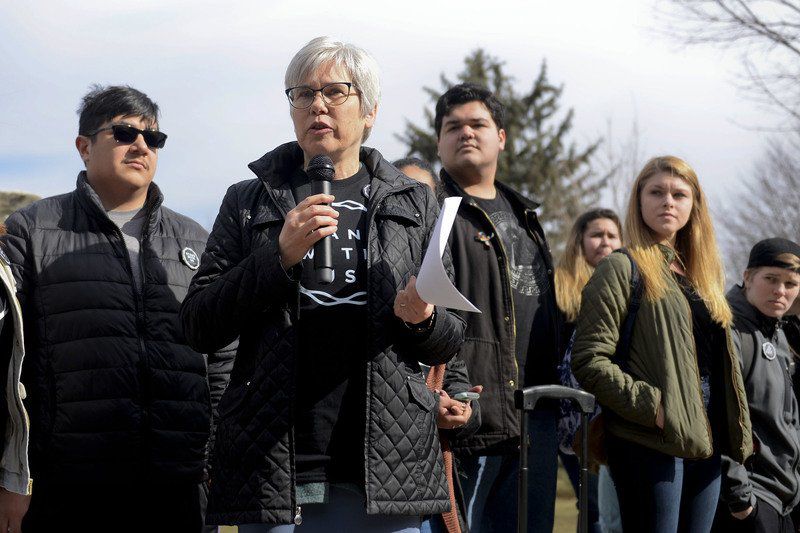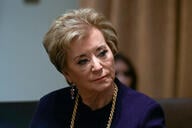You have /5 articles left.
Sign up for a free account or log in.
When Rebecca Stoltzfus was offered the president’s job at Goshen College in spring 2017, she talked it over with her husband and children and also sought the opinion of a former president of the institution whom she greatly respected and admired -- and with whom she’d always had great rapport.
To her surprise, the “very expressive” and “naturally curious” former president declined to share his opinion or discuss any aspect of the job. He thought it best to keep his own counsel.
“I said, ‘Daughter, this is your decision -- we will support you if you take it or if you walk away,’” Vic Stoltzfus, president of Goshen from 1984 to 1996, recalled.
By “we” he meant himself and Marie, his wife and mother of their daughter, Rebecca, who became Goshen’s 18th president Nov. 1. She was formally inaugurated Feb. 17, becoming one of a handful of college presidents to follow in a parent’s footsteps and lead the same college their fathers once led.
Rebecca Stoltzfus may be part of an even rarer breed as a woman leading a college where her father was president. And unlike the 22-year interval between Stoltzfus and her father’s presidencies, successions by sons have tended to be more immediate.
For example, Jerry L. Falwell Jr. was appointed president of Liberty University in June 2007, just one month after the death of Jerry L. Falwell Sr., who founded the Christian university in 1971.
Kevin M. Ross became president of Lynn University, a private university in Boca Raton, Fla., in 2006, after his father, Donald E. Ross, retired from the job he’d held for 35 years.
The leadership of Bob Jones University is perhaps the starkest example of familial lines of succession. Robert Reynolds “Bob” Jones Sr. founded the nondenominational evangelical Christian university in Greenville, S.C., in 1927 and was its first president. He was succeeded by his son, Robert Reynolds “Bob” Jones Jr., who served as president for 24 years and then as chancellor until his death in 1997. His son Robert Reynolds “Bob” Jones III followed and remained president until 2005, when his son Stephen Jones took over and served as president until 2014. (Steve Pettit, the current president at Bob Jones University, is its first leader not related to the Jones family.)
Rebecca and Vic Stoltzfus don’t see themselves in the same light as the father-and-son presidents of those other colleges. Vic was recruited to Goshen, a Mennonite institution in Indiana, in 1981 as academic dean. Rebecca enrolled at Goshen that same year. Her father was appointed president in 1984, a few months after she graduated with a degree in chemistry.
Father and daughter are still getting used to this new aspect of their relationship and trying to figure out how best to negotiate it.
He says he’s being careful not to use his past experiences as college president to influence her decision making. He’s also trying not to let his heart get in the way, which is why he passed on giving her advice about taking the job.
“If I would have disobeyed my own internal gag order, I would have said, ‘It’s the right time, you’re the right age and you have the right experience. Goshen College needs you, please take the job,’” he said.
“That’s very sweet to hear,” Rebecca Stoltzfus said when told of her father’s comments. “He trusted my discernment to know what was right for me and Goshen College. I could sense his curiosity but also his respect and restraint for my process. I never felt he was imposing his views.”
And even though she wanted his input, “I tried not to put too many expectations on him for this particular decision, or draw him in too much,” she said.
When she came to interview for the job, she stayed with her parents, who live across the street from the campus. Her father relented -- but just a little.
“The next morning as I was getting ready to leave, he said, ‘I thought about your request for advice and here’s what I would say: “Be open to the process and pray like crazy.' "
Ryan Sensenig, a professor of biological and environmental science who was on the presidential search committee that unanimously selected Rebecca Stoltzfus, said she stood out among “multiple high-quality candidates.”
“The committee was impressed with multiple aspects of the skills she brings to the job, including her familiarity with a small liberal arts college and the role it can play in society,” he said.
Sensenig also cited Stoltzfus’s experience as a scholar and researcher, her work in international education, and her past leadership roles in higher education overseeing budgets and utilizing financial resources. “She knows how to lead with inspiration and strategy,” he said.
“She came here with a keen sense of listening and understanding the challenges at Goshen,” he said. “She has hit the ground running in terms of working hard at moving the college forward. She’s extremely personable but also pragmatic and strategic.
“In her short tenure we have seen some exciting initiatives: a fund-raising campaign connecting with alumni, structured conversations on campus about mission and vision, and pragmatic plans to build upon our mission.”
Now, five and a half months into her presidency, Rebecca Stoltzfus is balancing her close relationship with her father while, at the same time, putting her own imprimatur on the college.
“I don’t want to involve him in way that would be inappropriate for this moment in life,” she said. “He’s been retired for a very long time. He’s no longer responsible to, or for, Goshen College. He’s not responsible for me. So it’s been very interesting navigating this.”
Still, the affection and pride they have for each other is apparent. It’s reflected in letters they wrote to each other about becoming president of Goshen. Hers was written in 1984, shortly before her father’s inauguration; his was penned last February, three days after her inauguration.
Rebecca Stoltzfus said the transition from Cornell University, where she was vice provost for undergraduate education and professor of human nutrition, to leading the private liberal arts college of 800 undergrads has gone well.
“I feel very lucky to not be starting from scratch at a college where I have no history or familiarity with the campus,” she said.
The president’s two children, Lydia and Gabe, now attend the college. (Lydia, a senior, will be graduating next weekend. Last November she formally introduced her parents before her mother spoke at the first all-campus convocation.) Because Rebecca’s parents still live nearby, she maintained her ties to the college and the larger community and established strong social networks.
“It has all been an asset to me,” she said. “It gave me a deep feel for the place and the mission” and the sense of “having a head start.”
Still, “there was something slightly disorientating” about being back on the campus, she said.
“The place I knew when I left in 1983 is different now, different and familiar all at once. There are some things I knew in ’83 that are no longer true."
To hear others tell it, she is having an extended honeymoon with faculty, staff and students, who give her high marks for her leadership style and intellect.
“It’s probably hard to overstate the almost universal support for her as the choice for president,” said Conrad Clemens, chair of the college’s Board of Directors. “It’s remarkable and it’s based on her background and the credentials she brought with her. Any time she spoke or was on campus, she came across as a high-quality person, and she just listens so well.”
Clemens, a professor of pediatrics at the University of Arizona College of Medicine in Tucson and a senior associate dean for graduate medical education, was a classmate of Rebecca Stoltzfus’s during the time her father was president of Goshen. He said her father’s status as a former president has no influence on people’s judgments of her.
“I don’t remember ever once where that issue came up in public,” he said. “Certainly people who have been around Goshen for a long time were aware that she was Vic’s daughter. It seemed to matter very little because she stood out on her own. I think if anybody was concerned about that, it was her. I’ve heard surprisingly little from the community about that, and I think part of it is because she’s so amazing that it’s silly to think she got that job on the back of her dad.”
Rebecca Stoltzfus also gets plaudits for helping foster a commitment to inclusiveness on campus as the college undergoes demographic shifts and the student body includes more students of color, especially Latino and Hispanic students.
In fall 2017, Goshen had the largest incoming freshman class in eight years, continuing three consecutive years of increased enrollment after more than five years of decline. The student body also became more diverse; for the fourth year in a row this year’s freshman class is the most diverse in Goshen’s history, with 49 percent of students identifying as nonwhite, according to the college’s spokeswoman. Over all, 36 percent of the student body are students of color, 23 percent of them Latino. (Diversifying the faculty has been less speedy. Eighty-nine percent of the college's full-time faculty, and 97 percent of the part-time faculty, are white.)
“When we have concerns that we want to talk about, we’re able to have access to her,” said Elijah Lora, president of the Goshen College Latino Student Union and vice president of the Student Senate. “She’s very interested in what students have to say and hearing students’ perspectives, which I very much value.”
Some students recently started the Intercultural Coalition of Goshen College, which represents the various intercultural clubs on campus. The ICGC’s goals are to address the lack of diversity among faculty and problems with racism on campus, among other issues that have caused tensions.
One incident that stood out involved a Palestinian student who complained to an intercultural club he belonged to about being verbally assaulted while leaving class one day last semester.
“They called him names; they said his religion was a joke and that he didn’t belong on campus. He said he felt very threatened,” Lora recounted.
“However few and far between these types of instances are, we still want to address them and create a better community on campus,” he said. “And there are still other smaller examples of incidents.”
Last month, 100 or so students, some of them wearing black T-shirts inscribed with “Stand With Us”, staged a walkout on campus and marched from the chapel to the administration building. The group’s leaders met with Stoltzfus and presented her with a “resolution” listing policy changes they said were needed. They also gave her a T-shirt like the ones they were wearing.
Among other things, the list called for mandatory antiracism training for professors, teaching assistants, coaches, resident assistants, student leaders and student athletes; annual reports detailing all incidents of racial misconduct on campus; the hiring of a Director of Diversity, Equity and Inclusion; and the creation of an intercultural resource center.
 As the students took turns speaking during their rally outside the administration building, the president joined them and addressed the crowd. She was wearing the T-shirt given to her earlier. She told the students that she’d read their mission statement and that she would work with them.
As the students took turns speaking during their rally outside the administration building, the president joined them and addressed the crowd. She was wearing the T-shirt given to her earlier. She told the students that she’d read their mission statement and that she would work with them.
“One of the things that I know about this community is that it is not perfect, but I hope that today helps us take steps toward being more honest and being in new depth of conversation about the Goshen College community and the Goshen College experience that we want to create together,” she told them. “And it will take all of us, I believe, to do that.”
The march was followed by an April 11 town hall meeting on campus to address the students’ concerns. Stoltzfus was there along with other members of her cabinet.
After the students described initiatives they were working on, Stoltzfus asked why only students were being charged with doing all the work.
“She said, ‘Why not make the programs more robust?’” and include faculty and other stakeholders, Lora recalled.
“I expected resistance and defensiveness,” he said. Instead they got support and validation.
“It was really impactful,” Lora said. “It totally turned around the way we were looking at things. She really tried to work with us on addressing the concerns that we’ve had for a long time that are just now being addressed. We’ve had really positive interactions with her.”
Those interactions helped him understand the reception the new president got when she arrived on campus.
“It was really interesting to see how people embraced her. It felt like she was already part of the community,” he said.
Faculty members echo those sentiments.
“We’re delighted she’s here,” said Kathy Meyer Reimer, chairwoman of the Academic Affairs Committee, a decision-making body similar to a faculty senate. “She has a very relational style of leadership. She is very willing to talk with people, to have discussions, to bring ideas and discuss others’ ideas as part of the decision-making process.”
Meyer Reimer, a professor of education, was also Stoltzfus’s classmate and friend at Goshen. She points to the “soup and bread” dinner gatherings Stoltzfus hosts at her home as a signature example of her relatability and openness.
Stoltzfus started the so-called soup talks just weeks after she arrived to Goshen as a way to meet some of the people on campus and learn about the issues important to them. The informal get-togethers involved small groups of students, faculty or other staff talking over a simple meal of soup, salad and bread -- and cookies for dessert. Stoltzfus held 13 soup talks throughout November and December and met with 128 people in all.
“It was very structured,” Meyer Reimer said. A student note taker was on hand. (After all the guests departed, Stoltzfus and her husband, Kevin Miller, also wrote detailed summaries, from memory, of what was discussed. They then emailed the summary to the guests for their approval.)
“The conversation during the first half of the meal was about ideas, our hopes for the institution and things we wanted her to be aware of,” Meyer Reimer said. Then they went to living room for coffee and cookies, where the conversation shifted to how to move from “vision to mission.”
By the end of January, Stoltzfus had turned all the information culled from the talks into a report with sophisticated data analysis and an impressive summary. The document became the college’s new vision statement that she presented at an all-employees meeting on campus. The Board of Trustees endorsed it.
“Oh, she’s done a lot,” Meyer Reimer said, citing Stoltzfus’s hiring of a new academic dean and her fund-raising abilities.
Stoltzfus has already raised $1 million for her newly created President's Innovation Fund and earmarked it for partially restoring employee retirement benefits that had been reduced, raises for the custodians and a “faculty renewal” fund to help pay travel costs to conferences and other events.
Stoltzfus also continues to do academic research and is continuing a multiyear research project in Africa that she started while at Cornell. Last month she and two Goshen professors traveled to Arusha, Tanzania, and joined an international team of researchers at the Nelson Mandela African Institute of Science and Technology who are working on a project to make food safer for mothers and children
“So when you consider these last five months, it’s quite a broad spectrum of the whole institution that she’s been able to influence and improve,” Meyer Reimer said.




